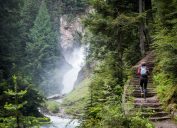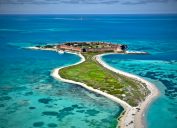The 13 Best U.S. Rivers for Swimming
From lazy rivers to a natural "waterslide," these waterways are must-see destinations.

Most travelers looking to enjoy some time on the water tend to focus on beaches and lakes for their summertime destinations. But if you're looking for an equally relaxing getaway in the outdoors, rivers can be a refreshing alternative. These places provide plenty of stunning natural beauty often with fewer crowds, whether you're planning to kayak, tube, float, or just take a dip. Read on for the best rivers in the U.S. for swimming, according to travel experts.
READ THIS NEXT: 10 Best Cities in the U.S. for Outdoor Adventures.
The 13 Best U.S. Rivers for Swimming
1
Columbia River, Washington and Oregon
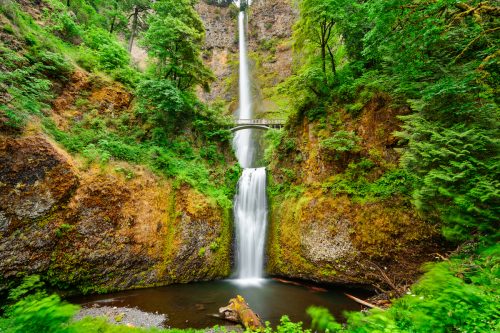
The Columbia River is the largest river in the Pacific Northwest, flowing more than 1,200 miles from the Rocky Mountains in British Columbia, Canada through Washington and Oregon. On the border of the two U.S. states is the Columbia River Gorge, "a spectacular river canyon, 80 miles long and up to 4,000 feet deep, that meanders past cliffs, spires, and ridges set against [the] Cascade Mountain Range," according to the USDA Forest Service.
The entire gorge is not viable for swimming, but Matt James, founder of travel blog Visitingly, recommends heading to the city of Cascade Locks in Oregon, a 45-minute drive west from Portland. "There are a number of public beaches and parks, as well as a few private ones," he says. Cascade Locks is also close to Multnomah Falls, a famous 620-foot-tall waterfall.
Another popular swimming spot is in Hood River, "a charming small town" also on the Oregon side, according to Jessica Schmit of the travel website Uprooted Traveler. She explains that this area is known for its "vibrant windsurfing and kitesurfing community," as well as for the views it affords of Mount Hood.
2
Snake River, Idaho
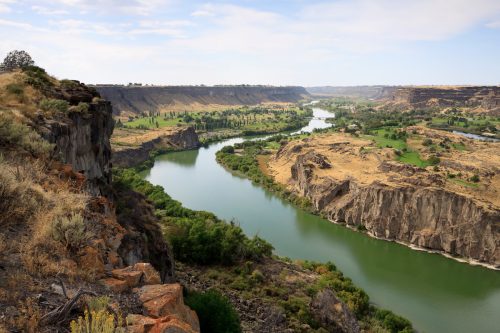
A tributary of the Columbia River, the 1,078-mile Snake River begins in Wyoming at Yellowstone National Park, travels through southern Idaho and Oregon, and ends in Washington. It's extremely well known for whitewater rafting in Jackson Hole, but all through Idaho, there are lovely spots for swimming.
Melissa Barry, executive director of Visit Southern Idaho, suggests Blue Heart Springs. It's only accessible via water transportation (boat, kayak, canoe, paddleboard), but if you're up for it, it's well worth it to see the crystal-clear teal blue water. Barry's other favorite swimming location is Ritter Island, which is part of Thousand Springs State Park. "Clear spring water comes out of the canyon sides and flows around the island and into the Snake River. People will float around the island with only a short part going against the current," Barry says.
RELATED: The 12 Best U.S. Cities for Outdoor Adventures.
3
Merced River, California
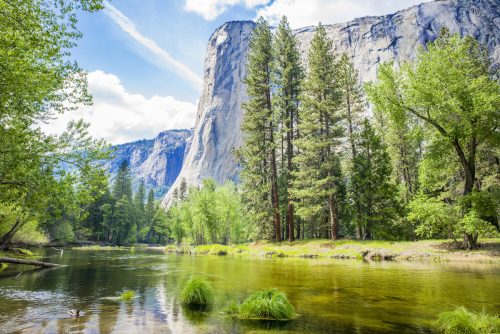
The Merced River runs through a glacially-carved canyon within Yosemite National Park. According to the National Wild and Scenic Rivers System, it flows along "glaciated peaks, lakes, and alpine and subalpine meadows—in alternating pools and cascades." In the spring, it's surrounded by lush wildflowers.
Though the Merced River is another prominent spot for whitewater rafting, there are several areas well suited for more passive swimming. "While most visitors flock to the famous viewpoints at Sentinel Beach and Valley View, Cathedral Beach sits between the two and seems to be just enough off the beaten path that we've never had trouble finding a parking or lounging spot," says Kristy Esparza, founder of family travel blog JJ & The Bug. She also notes that this is a great place to view El Capitan, Yosemite's 3,000-plus foot-tall granite rock formation.
4
Guadalupe River, Texas

Texas Hill Country is known to draw plenty of visitors all months of the year. But those looking to cool off during the hotter summer months might consider a dip in the Guadalupe River, located in a state park bearing its name.
"The Guadalupe River meanders through picturesque landscapes, carving its path with stunning limestone cliffs and towering cypress trees," says Maddi Bourgerie, a travel expert with RVshare. "Originating in Kerr County, the river flows eastward for over 230 miles, offering a diverse range of experiences along its course."
Others appreciate its relative convenience. "It's a consistent favorite among travelers for a family getaway, and it's an easy drive from San Antonio," says Erin Stender, chief marketing officer at outdoor travel company Campspot. "Visitors can beat the summer heat and find shade thanks to thanks to the giant cypress trees lining the banks."
Here, she says the vibe is relaxed and offers a bit of something for everyone, whether that means shallower wading areas for younger children or deeper sections for floating and swimming depending on water levels.
"And with fantastic hiking trails and convenient camping options nearby, it's easy for families to turn a day trip into a longer, more enjoyable stay," Stender adds.
5
Colorado River, Arizona
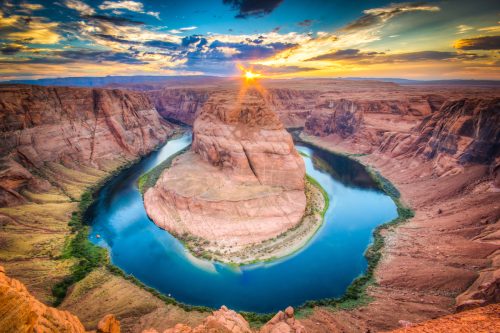
The Colorado River begins in its namesake state, at the Rocky Mountains, traveling southwest through Utah, Arizona (where it flows through the Grand Canyon), Nevada, California, and Mexico, where it ends. But it's a stretch of the river in Arizona that is unparalleled for swimming (and Instagramming).
"One of the most popular sections of the river is in Arizona, where it winds through the majestic Horseshoe Bend," James says. In addition to its unique shape, red and orange rock formations, and "beautiful turquoise waters," he says it's so special because "it's one of the few places where you can really see the Colorado River in all its glory. The river is so big and so powerful, and at the Horseshoe Bend, you can see it in all its might."
RELATED: The 10 Most Naturally Beautiful States in the U.S., New Data Shows.
6
Oak Creek, Arizona

Oak Creek is technically a stream, but it's so amazing that we had to include it. Located 14 miles south of Sedona, the stream flows through the famous Oak Creek Canyon, a 12-mile-long gorge that's "carved into the edge of the Mogollon Rim of the Colorado Plateau," according to the USDA Forest Service.
There are two spots to go swimming in the canyon: Grasshopper Point and Slide Rock State Park. The latter is so named "because a thick layer of algae on the bottom literally turns the river into a 100% natural waterslide," explains Katie Caf, founder of travel blog Katie Caf Travel. "After 80 feet of sliding, it drops you off in Oak Creek Canyon," she says.
Steve Morrow, travel expert and founder of Paddle About, adds that "the red rock formations and clear, cool water make it a popular spot for swimming, tubing, and picnicking."
7
Truckee River, California and Nevada

You probably know all about Lake Tahoe, but did you know about the river in Tahoe? The 145-mile Truckee River begins in California's Sierra Nevada mountain range, flows through Lake Tahoe, continues down the Truckee River Canyon to Reno and the desert, and ends at Pyramid Lake, according to the Water Education Foundation.
But one of the most popular spots for getting in the water is in Tahoe City, California. "Drive into Tahoe City on a warm summer day and you can't miss them—the big tents set up alongside the sparkling Truckee River, where operators rent out inflatable rafts and inner tubes for a do-it-yourself day on the water," says Visit California. The tourism agency also notes that this part of the river has a calm current, making it great for kids (and dogs!).
For something more adventurous, head to Reno, Nevada, and "ride through the half-mile downtown Truckee River Whitewater Park featuring five man-made rapids," suggests Alexa Pope, a public relations specialist who works with the city of Reno.
8
Lower Klamath River, California

Sometimes, the best-preserved places can make for the best river experiences. And according to Jackson Groves, travel writer and founder of Journey Era, this includes the Lower Klamath River in California.
"As a kayaker and stand-up paddleboarder myself, I can attest that its flatwater sections provide the perfect setting for non-motorized water activities," he tells Best Life. "When I visited last summer, the water was crystal clear, allowing me to spot schools of fish and birds wading along the shoreline. Being surrounded by the rugged beauty of the Klamath Mountains added to the appeal."
He says that its accessibility is also a strong point, with numerous public access points where you can easily launch watercraft or get in to take a dip. "Campgrounds and picnic areas are scattered along the river as well for travelers who want to make a weekend of it," Groves adds. "I especially enjoyed the views around some of the grassy bars and islands you can stop on."
There's also plenty of exploring and hiking to keep visitors busy. Many make their way to Ukonom Creek to view the side-by-side waterfalls that empty into a nearly perfect swimming hole, according to Visit California.
RELATED: The 7 Newest National Parks You Need to Add to Your Bucket List.
9
Frio River, Texas
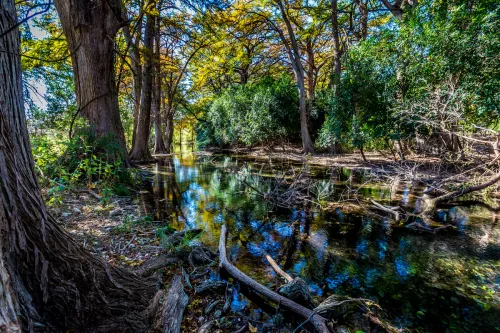
In Spanish, "frio" means cold—which is fitting since this river in Hill Country Texas is cool year-round. "Running shallow and startlingly transparent over a limestone and gravel bed, [the river is] pocked with deep pools and charged by springs that keep the water temperature refreshingly cool even in mid-July," explains Texas Highways. More than how refreshing it is, Visit Uvalde County says the river is worth a visit for the beautiful views that include "tall limestone bluffs, big cypress trees, and stunning birds."
Like the Truckee River, the Frio River is popular for its leisurely tubing, which Texas Highways says is best near the Frio Canyon. The magazine notes that there are plenty of places to rent rafts or kayaks, as well as many "mom-and-pop" vacation rentals ranging from "rustic cabins and simple campgrounds to country clubs, gated resorts, and lavish lodges."
10
Buffalo National River, Arkansas

Flowing through the Ozark Mountains, Arkansas' Buffalo National River is "one of the few remaining undammed rivers in the lower 48 states," according to the National Park Service (NPS). "Prepare to journey from running rapids to quiet pools while surrounded by massive bluffs," they describe.
The Buffalo National River has three districts—lower, middle, and upper—explains Caitlin Dismore of travel blog Twin Family Travels. "The upper district has an excellent swimming spot near the Steel Creek Campground," she says. For those kayaking, the eight-mile section between Steel Creek and Kyles Landing offers "tumbling rapids and long, cerulean pools," as the NPS notes.
Dismore also suggests Buffalo Point in the lower district for swimming, which she says is "popular year-round for camping and paddling." Those who paddle here from Dillards Ferry will pass Skull Bluff, an enormous limestone bluff with two holes (eyes) in it through which you can paddle in low tide.
RELATED: 7 Best Wellness Retreats in the U.S. This Year, According to Experts.
11
Kennebec River, Maine

Most travelers flock to Maine in the summer for its numerous beaches and famously rugged coastline. However, the interior of the state can be just as much of a draw, thanks to the Kennebec River.
"I have to say, when we spent one weekend rafting down the Kennebec, the clarity of the water really struck me," says Michael Donovan, a travel expert and co-founder of StayNewEngland.com. "Even with its mixed sections that were clearer or more turbid depending on conditions, it never felt unsafe or unclear. Everything just felt very well-balanced."
He adds that those kayaking or tubing are also in for a scenic treat. "Floating down that tight 12-mile gorge with towering red sandstone cliffs lining both sides, capped by a blanket of bright autumn foliage or lush spring greenery, it really takes your breath away," Donovan promises.
12
Ichetucknee River, Florida

Though it's only six miles long, the Ichetucknee River is not to be missed. Located in northern Florida, it's part of Ichetucknee Springs State Park, "a 2,669-acre wildlife haven," according to Florida State Parks. It's fed by eight springs, "meaning that it is pristine, having green and blue hues that are reminiscent of a tropical lagoon," explains Michelle Henry, founder of the blog Outdoor Dog Fun.
The Ichetucknee River is perfect for tubing, canoeing, and kayaking. As you float down the water, you'll see "moss-draped cypress [and] limestone banks," as well as "wading birds, manatees, and river otters," says Florida State Parks. And if you hike the half-mile Blue Hole Trail, you can swim, snorkel, or scuba dive in Blue Hole Spring, which stays at 72 degrees all year and is situated above an intricate system of underwater caves.
13
Delaware River, Pennsylvania and New Jersey

New York's Hudson River may be historically significant and beautiful to look at, but it's not the best for swimming. For that, people travel a bit southwest to the Delaware River, which traverses Pennsylvania, New Jersey, and Delaware. "The Delaware River is one of the cleanest rivers in the country, and it's regularly tested to ensure that it meets all water quality standards," says James. In the summer, he adds, "the water temperature is usually between 70 and 80 degrees."
The prime spot for water activities is the Delaware Water Gap National Recreation Area, which straddles northern New Jersey and Pennsylvania. According to the NPS, there are "100+ miles of hiking trails, designated picnic and grilling areas, and three swim beaches." There are also several large waterfalls here that can be explored.
This story has been updated to include additional entries, fact-checking, and copy-editing.






